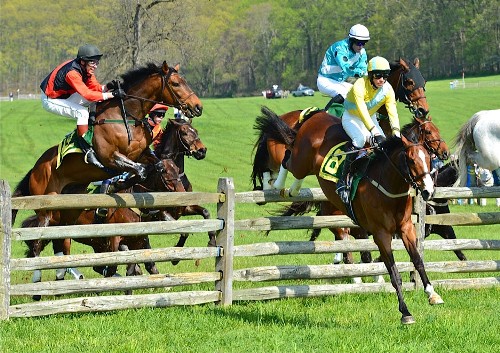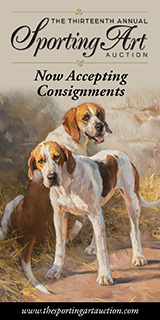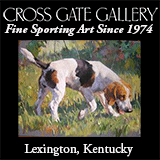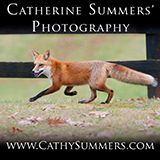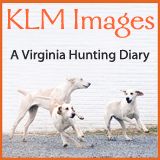Thoroughbred
Country Pursuits: The Mellon Collections
Country Pursuits: British, American and French Sporting Art from the Mellon Collections in the Virginia Museum of Fine Arts, by Malcolm Cormack, Published by the Virginia Museum of Fine Arts in association with the University of Virginia Press, 2007, 474 pages, illustrated, $62.00What a debt we all owe the late philanthropist Paul Mellon, whose love of horses and horse sports was expressed through the fabulous art collections that he so generously shared with us.
The Eclipse Award-winning breeder saddled legendary Thoroughbreds Sea Hero, Arts and Letters, and Mill Reef, just to name a few. His first British art purchase, in 1936, was a painting of a racehorse, "Pumpkin with a Stable-lad" by George Stubbs, said to be his favorite painting by one of his favorite artists. Pumpkin won sixteen out of his twenty-four races at Newmarket turf in the late 1770s and was described as an excellent runner.
“It was my very first purchase of a painting,” Mellon recalled later, “and could be said to be the impetus toward my later, some might say gluttonous, forays into the sporting art field.”
That Stubbs painting was donated to his alma mater, Yale, but the Virginia Museum of Fine Arts was another lucky recipient of Mellon’s “gluttonous” obsession with sporting art. Mellon’s donations are explored in Country Pursuits: British, American and French Sporting Art from the Mellon Collections in the Virginia Museum of Fine Arts by Malcom Cormack. Cormack was the Paul Mellon Curator at the VMFA in 1991 until his retirement in 2004. He also once served as the Curator of Paintings at the Yale Center of British Art established by Mellon.
Winning in Tax Court with Thoroughbreds
Peter J. Reilly, writing in Forbes, tells of a recent tax court case won by a taxpayer claiming horse business losses, despite the taxpayer’s failure to satisfy all the classic IRS tests. The taxpayer was a successful businessman whose annual salary averaged around one million dollars from his concrete business. He suffered losses, however, from his other business—owning and racing Thoroughbreds—from which he obviously derived much pleasure. He passed some of the IRS tests, but was weak in others. However, he worked very closely with his trainer, and it was that relationship upon which the case turned. The IRS questioned, with good reason, the intensity of the taxpayer’s profit motive. However, because the taxpayer worked so closely with his trainer, the court decided that the two were essentially embarked on a joint venture, and that the trainer certainly had a strong profit motive, in that training and racing Thoroughbreds was his primary business. The court concluded that the taxpayers motive was, therefore, the same. Click to read the complete article. Posted November 22, 2014
Read More
Edward Troye, Harry Worcester Smith, and Alexander Mackay-Smith: Archival Research Connects the Dots
Edward Troye gained artisitic renown painting America's greatest bloodstock of the mid-twentieth century. / 1872 photographic print, National Sporting Library and Museum Archives, Harry Worcester Smith papersFoxhunting Life is proud to publish this preview of the stories behind one of the most important exhibition of the works of Edward Troye ever mounted.
It is said that “traces of the soul can be found in boxes in the archives.” Where letters, scrapbooks, newspaper clippings, jotted notes-to-self and snippets of individuals’ lives are kept, distractions lurk and surprises are inevitable. And patience is rewarded with a story.
The archives of the National Sporting Library and Museum in Middleburg, Virginia contain the story of three men whose lives spanned two centuries, whose interests overlapped, and whose souls were kindred: Artist Edward Troye (1808-1874), the indomitable sportsman Harry Worcester Smith (1864-1945), and the scholar, chronicler, and author Alexander Mackay-Smith (1903-1998).
Wise Dan in Rarified Company after Second Horse of the Year Title
Not since 1971—the introduction of the modern system of Eclipse Award voting—has a horse won three categories of awards—Horse of the Year, Older Male, and Male Turf Horse—two years in a row. Wise Dan did so by winning six of his seven starts on turf, carrying high weight in five races, and winning four Grade I races in 2013 at tracks across North America. He had a consistent season and was never scratched. In Horse of the Year voting he polled ten times the number of votes as his closest runner-up, Mucho Macho Man. The year before, after his 2012 season, Wise Dan became the first horse to win all three categories since John Henry in 1981. One of only six horses in modern history that have won consecutive Horse of the Year honors, Wise Dan joins Secretariat, Forego, Affirmed, Cigar, and Curlin in that accomplishment. Now seven years old, the chestnut gelding is by Wiseman’s ferry out of Lisa Danielle by Wolf Power. He was bred at home by owner Morton Fink in Kentucky and is trained by Charlie LoPresti near Lexington. His post-season rest over, Wise Dan is now gearing up for the 2014 season at Keeneland, his home base. Click for more details in Claire Novak’s article in Bloodhorse. Posted February 17, 2014
Read More
From Horses to Hounds: Following the Seasons
Professor Maxwell lands cleanly at fence 3 of the Maryland Hunt Cup. / Douglas Lees photo The hunt point-to-points are over, and Foxhunting Life ends its season’s coverage with a report on the Maryland Hunt Cup. We report on these races because they are foxhunting-related; amateur riders compete, and many of these racehorses also serve as field hunters. And what field hunters they are! Click to read Anne Hambleton’s article, “Thoroughbreds: Kings of the Hunting Field.” With the racing and Thoroughbred journals now covering the sanctioned races, FHL switches its focus from horses to hounds. We start our hound show reports with the Southern Hound Show, first of the season. We’ll report on the Southwestern Hound Show next week. Follow our coverage; learn more about hounds. We generally focus on the grand champion of show, and we always find a good story to tell! Posted May 4, 2013
Read More
The Road to the Kentucky Derby
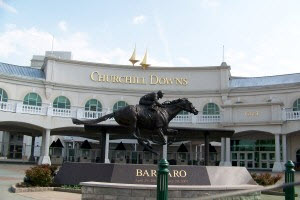 Odds are high that most Foxhunting Life readers will tune in to the Kentucky Derby on the first Saturday in May to watch "the most exciting two minutes in sports." It's arguably the finest show of racing talent each year from the horses to the trainers to the jockeys who are all aiming for the glory of winning the Kentucky Derby cup and sharing in the two million dollar purse.
Odds are high that most Foxhunting Life readers will tune in to the Kentucky Derby on the first Saturday in May to watch "the most exciting two minutes in sports." It's arguably the finest show of racing talent each year from the horses to the trainers to the jockeys who are all aiming for the glory of winning the Kentucky Derby cup and sharing in the two million dollar purse.
Websites like www.kentuckyderbybetting.com are excellent resources to get you up to date on the background and history of the 'Run for the Roses.' There is also a section on Kentucky Derby horse odds which is invaluable if you are planning on increasing the excitement by having a flutter on your favorite contender this year.
It's easy to get emotionally attached to a horse that you believe can win the big prize. Some foxhunters take the connection even further by buying retired racehorses and giving them a whole new lease on life. Here's a recent FHL article on Thoroughbreds in the hunting field.
Nancy Milburn Kleck Art Studio
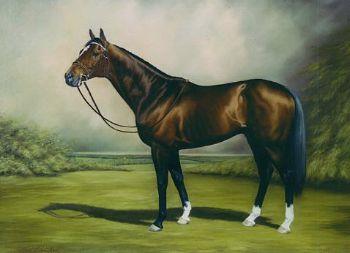 Cigar by Nancy Kleck, 24 x 30 inches, oil on canvasEquine and sporting artist Nancy Milburn Kleck has relocated her art studio from the Kentucky Bluegrass country where she lived for twenty-five years to Bluemont, Virginia, near historic Upperville and Middleburg. She relishes the opportunity to expand the scope of her work from mostly racehorses to the foxhunting field as well.
Cigar by Nancy Kleck, 24 x 30 inches, oil on canvasEquine and sporting artist Nancy Milburn Kleck has relocated her art studio from the Kentucky Bluegrass country where she lived for twenty-five years to Bluemont, Virginia, near historic Upperville and Middleburg. She relishes the opportunity to expand the scope of her work from mostly racehorses to the foxhunting field as well.
Thoroughbred Industry Woes Linked to Medication
The Thoroughbred racing industry is tanking in the U.S., and racing industry leaders from around the world blame the decline on our permissive medication practices. From 2007 to 2010, on an annual basis, the registered foal crop in the U.S. declined nineteen percent, races run declined almost ten percent, purses fell more than twelve percent, and betting dropped twenty-two percent. World racing leaders spoke up at a recent International Summit on Race Day Medication at Belmont Park on June 13 and 14. Denis Egan, the chief executive of the Irish Turf Club, said, “European buyers are drifting away because we view the performance of U.S. horses with skepticism because of the medication policies, and the stallions are not comparable to clean European stallions.” The Hong Kong Jockey Club has perhaps the most stringent medication rules in the racing world. Yet Hong Kong, with a population of seven million, and with racing only eighty-three days per year, saw nearly $10.3 billion in bets pass through the windows last year—almost as much as the entire U.S. The strict policies are good for business, insists Bill Nader, executive director of the Hong Kong Jockey Club. Over the past five years only one racehorse in 5,692 experienced sudden death while racing. In the U.S. the fatality rate is one in five hundred starters—worse by a factor of more than ten. Much of the conference’s focus was on Lasix, a drug used to reduce exercise-induced bleeding in the lungs. Lasix also improves performance, so nearly all horses in the U.S. go to the gate with a dose of the drug, whether they need it or not. Dr. Anthony Stirk, senior veterinary advisor to the British Horse Racing Authority urged American horsemen to get in step with the rest of the world, not only in medication policies but also in racing less frequently. Joe Drape’s article of June 13 in the New York Times is the source for this material. Posted June 15, 2011
Read More


